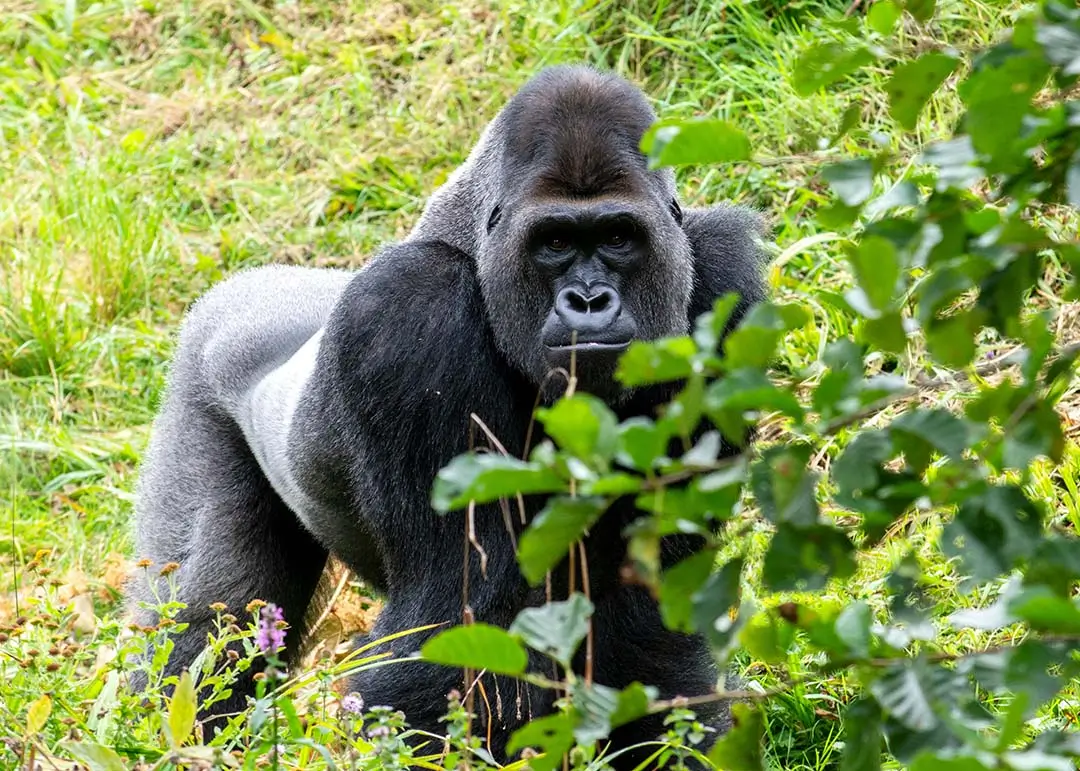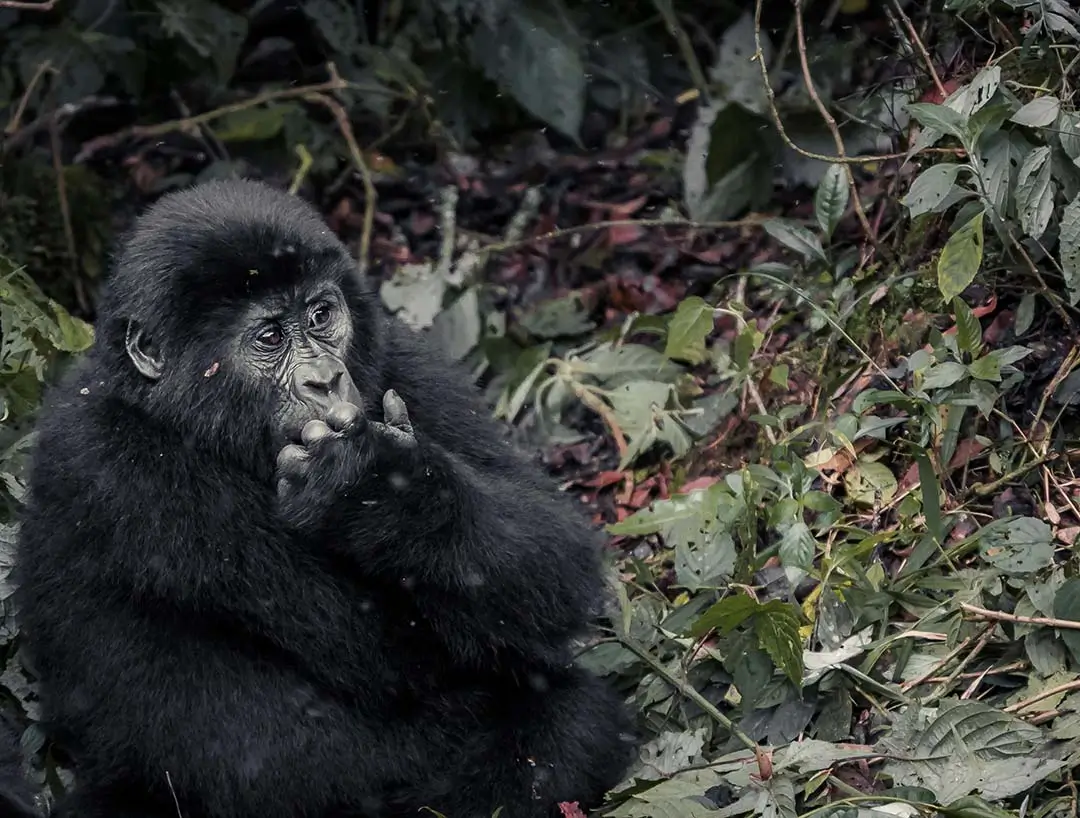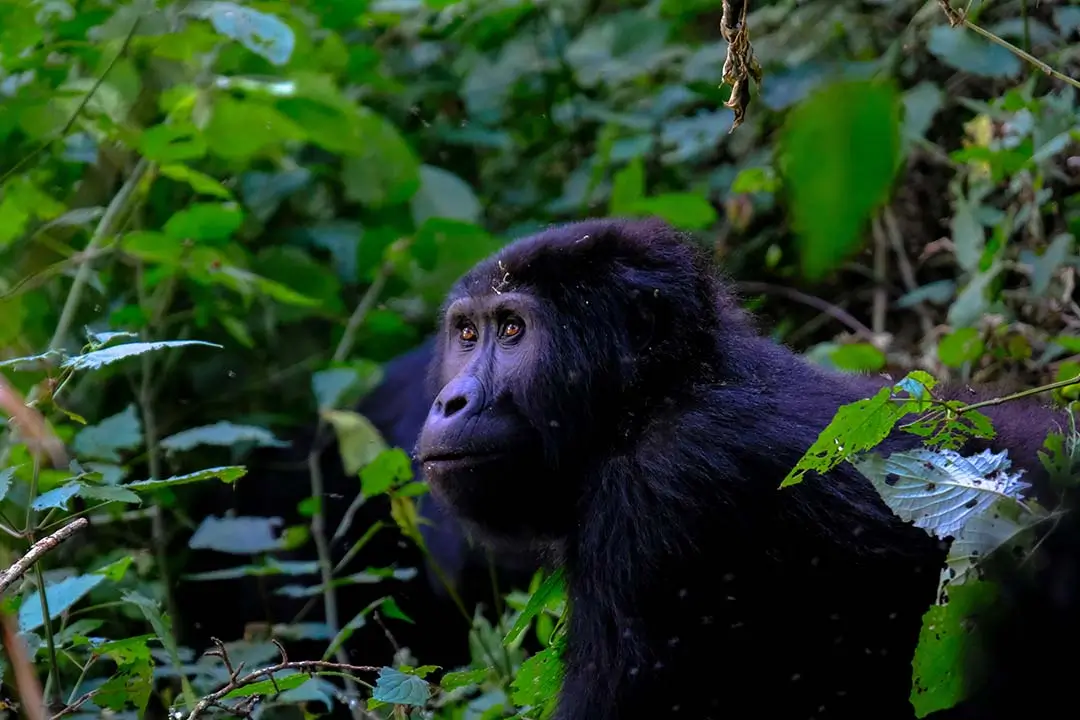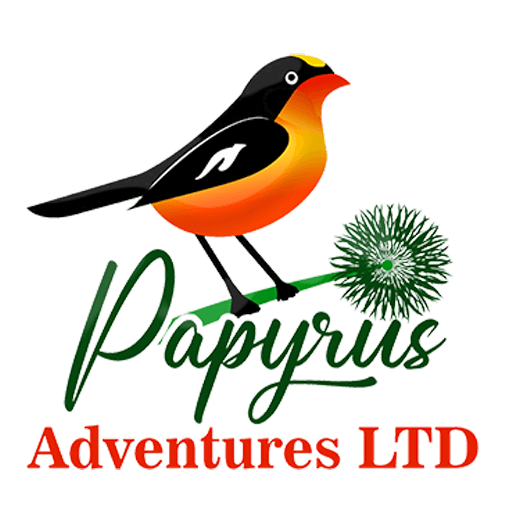You have a once-in-a-lifetime chance to observe gorillas in the jungles of Uganda by participating in a gorilla trekking trip with Papyrous adventures. One of the most rewarding animal encounters is coming face to face with a large gorilla. Finding a habituated family of gorillas in the mountains is the first step in gorilla trekking. You have an hour with them after you find them. Families of six to twenty gorillas typically depart together. A dominating silverback male leads a family. The two national parks that have the most mountain gorillas in Uganda are Mgahinga Gorilla National Park and Bwindi Impenetrable Forest National Park.
For a tourist to track a gorilla family, it has to be habituated a process that gets gorillas to put up with human presence without fleeing or attacking humans. Habituation of gorillas is done by specialist researchers and trained park rangers who make incessant visits to the wild gorillas for a period of about two or more years thereafter the gorillas will recognize the humans to not be a danger and can accept their presence for a short period of time. In case of some kind of confrontation a trained park ranger knows how to communicate with the gorillas to calm them down and make sure the tourists are safe.
Tourist can participate in the Gorilla Habituation experience at Bwindi, where tourists join the habituation experts for approximately four hours and get to learn more about them and their habitation. The gorilla population in Bwindi Impenetrable forest and Sarambwe Reserve in Democratic Republic of Congo increased to about 459 of them. Uganda has approximately 20 habituated families of gorillas, 19 in Bwindi and 1 family in Mgahinga Gorilla National Park The gorilla trekking experience in Bwindi Impenetrable National Park and Mgahinga National Park differ a bit and hear is why; Bwindi is an opaque jungle forest with thick bushes on rolling highlands whereas the trek in Mgahinga is up the volcanoes where gorillas are found in mid vegetation which is not impenetrable in an open area presenting great gorillas views.
Gorilla Trekking in Bwindi Impenetrable National Park
Bwindi Impenetrable forest national park is Uganda's main gorilla trekking destination. Bwindi has four sectors with habituated gorilla families that can be accessed by tourists. These include; Buhoma and Ruhija in the Northern part, Rushaga and Nkuringo in the Southern part. There over 50 gorilla families and only about 21 families are habituated and are accessed by visitors in the 4 tracking sectors. Mgahinga has one region for trekking called Ntebeko with Nyakagezi Gorilla family as the only gorilla group habituated for tourists. This group used to migrate a lot between Democratoc Republic of Congo, Uganda and Rwanda but have stayed out since 2012 in Uganda.
The habituation of gorillas takes about 2 years where the gorillas get used to human beings around them watching them as they do their daily activities in the wilderness. Uganda Wildlife Authority only permits 8 visitors per group per day and 15 years and above to see the gorillas. There are 160 permits for tracking gorillas per day in Bwindi. Topography is different and the time taken is always irregular as gorillas move to new places everyday and never reside in one place two times. Trekking can take around 2 to 3 hours today and next day it can go for 5 hours. A tourist can book for any permit for a sector of their choice via their chosen tour operator.
Do You have any Questions?
Our Experts are ready to provide answers
Gorilla Families in Bwindi per Sector
Buhoma Sector Of Bwindi: Habinyanja Gorilla Family
- Group size: 17 members including 1 silverback
- Named after a body of water referred to as Nyanja a swamp in Bwindi where it was first sighted.
- Was ready for visitation by tourists in 1999 after habituation.
- Group had many dominant silverbacks that fought for leadership hence splitting and forming another group called Rushegura.
- Group is now led by a wise alpha female called Makara.
- Tracking this family takes about 3 to 8 hours and it would be favourable if the tourists also found lodging in Buhoma.
Buhoma Sector Of Bwindi: Mubare Gorilla Family
- Group size: 9 members including 1 silverback
- Oldest habituated gorilla group in Uganda.
- Found in the Mubare hills and was habituated in 1998
- Started with 12 members under the leadership of Ruhondeza the dominant silverback.
- As group grew to 18 members there were fights with other wild gorillas and the group lost members including Ruhondeza the main leader.
- In 2013, other gorillas joined the then 5 member group making it a faction of 11. Kanyonyi the new silver back joined with the new members.
- This group's permits are popular with tour operators due to its proximity with Queen Elizabeth National Park.
Buhoma Sector Of Bwindi: Rushegura Gorilla Family
- Group size: 17 members: 1 silverback, 4 blackbacks, 4 adult females, 4 juveniles, 4 infants and is headed by Kabukojo.
- Group came together in 2002 when a silverback in Habinyanja broke away.
- Started with 12 members and got their name from Ebishegura a tree species very common in the area.
- Not far from Buhoma village and they are the shortest distance for trekking in the shortest time. But sometimes the gorillas go for an adventure.
Buhoma Sector Of Bwindi: Katwe Gorilla Family
- Group size: 7 members including 1 silverback
- Most recent group habituated and opened for trekking in August 2018.
- 32 gorilla permits available in Buhoma because of this additional group.
Buhoma Sector Of Bwindi: Muyambi Gorilla Family
- Group size: 7 members, headed by 1 silverback - Muyambi
- This is the newest group in Buhoma commenced in 2019.
- Led by Muyambi who split away from Mubare group.
- Have a new addition that arrived in May 2020.
Ruhija Sector of Bwindi: Bitukura Gorilla Family
- Group size: 13 members; 4 silverbacks, 4 adult females, 2 juveniles and 3 infants and is headed by Ndahura
- Named after a river where the group was sighted first.
- Habituated form July 2007 where the gorillas encountered Uganda Wildlife Authority rangers and this process took about 15 months for the group to be ready for visitation by humans.
- Habituation took a short time here because the gorillas had an earlier connection with the Uganda Wildlife Authority rangers.
- Some members split from this group along the way.
- Bitukura group likes scrounging around Ruhija tourism station.
Ruhija Sector Of Bwindi: Oruzogo Gorilla Family
- Group size: 17 members: 2 silverbacks, 2 black backs, 5 adult females, 2 sub-adults, 1 juvenile and 5 infants headed by Bakwate
- Started being trekked by visitors in 2011 and it's among the well-liked groups with tourists.
- Named after a plant they like to feed on called Alchornea hitela plant which is locally known as Oruzogo.
- Not an intense trek but needs endurance.
Ruhija Sector of Bwindi: Kyaguliro Gorilla Family
- Group size: 10 members: Headed by Rukara - the Silverback 2 blackbacks, 3 adult females, 2 juveniles and 2 infants.
- Group devoted for purposes of research whose habituation started in 1995.
- Rukina the main leader died of lightening on April 7th 2015 and an inexperienced leader called Mukiza took over and was later attacked surprisingly by dominant Rukara from Bitukura group.
- Group split in May 2016 creating two groups named Kyaguliro A led by Rukara and Kyaguliro B led by Mukiza
- Group spends most of its time in the inner forest.
Ruhija Sector Of Bwindi: Mukiza Gorilla Family
- Group size: 10 members: Headed by Mukiza - the Silverback, 4 adult females, 1 sub-adult and 4 infants.
- Was under Kyaguliro before under leadership of Rukina who was killed by lightening in 2015.
- Mukiza took over leadership buy was ambushed by Rukina leading to the splitting of the group.
Nkuringo Sector of Bwindi: Nkuringo Gorilla Family
- Family size: 11 members: 2 blackback, 2 adult females, 2 subadults, 3 juveniles and two infants. Headed by Rwamutwe - a black back.
- First sighted in Nkuringo which means a round hill. It's derived from Rukiga language.
- First gorilla group to be habituated in 1997 in the southern part of Bwindi. Habituated for 2 years.
- Group was led by a silverback called Nkuringo who died in 2004.
- Left behind Safari and Rafiki. Safari took over leadership in November 2004. Later Rafiki took over.
- Wildlife poachers on the dreadful day of 1st June 2020 killed 25 year old silverback called Rafiki who was the leader of the group. Because of the lockdown due to Covid-19 pandemic, there was no tourism economic activity happening around Bwindi which caused life to be tough for those near the park hence they resorted to poaching to survive.
- A month after the incident, a dominant Rwamutwe took over the leadership of the group.
- This group is known to venture into local neighborhood gardens to feed on sweet potatoes, bananas and others. This caused the local humans to move further away from Nkuringo hence creating a bulwark zone to lessen wildlife-human interface.
- The local community benefited directly from the tourists visits.
- Vigorous trek but intriguing.
Nkuringo Sector of Bwindi: Bushaho Gorilla Family
- Group size: 8 members: Headed by Bahati - theSilverback, 1 blackback, 3 adult females, 1 sub-adult, 1 juvenile, and 1 infant.
- Search launched in 2012 for members that walked away from Nkuringo.
- One of the members called SB Bahati moved from Nkuringo group and started his own group with some other gorillas from Nkuringo and other wild one.
- Group habituated thereafter and named Bushaho after where the group spends most of it time.
Rushaga Sector South: Nshongi Gorilla Family
- Group size: 10 members: 1 silverback, 3 adult females, 1 sub-adult, 2 juvenile and 3 infants.
- Named after River Nshongi where it was originally found and is headed by Bweza.
- Largest group to be habituated with 32 members.
- Opened in September 2009 for visitation
- This group strangely had 4 dominant male silverbacks.
- Group was previously led by Nshongi but split in July 2010 remaining with 26 members and the ones who left formed Mishaya Group led by Mishaya who later died in February 2014.
- The group split further and reduced to 18 members and the others formed the current Bweza group with 10 gorillas. When Mishaya dies the group split again and some went back to Bweza group while others formed the Bikingi group.
- Welcomed a new member in May of 2020.
Rushaga Sector South: Mishaya Gorilla Family
- Group size: 12 members with 1 dominant Silverback
- Mishaya left Nshongi group in 2010 with some females from non - habituated groups and started a gorilla family.
- Mishaya died in 2014. End of 2015 group had 7 members
Rushaga Sector South: Bikingi Gorilla Family
- Group size: 15 members: 1 silverback, 5 adult females, 2 sub-adults, 2 juveniles and 5 infants.
- Habituated in 2012 when they split from Mishaya group alongside the non-habituated gorillas.
Rushaga Sector South: Bweza Gorilla Family
- Family size: 12 individuals; 2 silverbacks, 4 blackbacks, 3 adult females, 1 subadult, and two infants.
- Formed after separation from Nshongi group which was the largest in Bwindi to be habituated.
- In July 2020, Mishaya the silverback decided to leave Nshongi and start his own group. He left with Bweza who decide to start his own group in 2012 walking away with 6 gorillas.
- Opened for tracking in 2014 after the habituation process.
Rushaga Sector South: Kahungye Gorilla family
- Group size: 17 members; 3 silverbacks, 3 blackbacks, 3 adult females, 3 sub-adult, 3 juveniles and two infants. The family is headed by Rumanzi.
- Discovered in Kahungye hill and named after this hill.
- Consisted of 29 members with 3 silverbacks in 2011 when it was opened for tracking.
- Group split after a rivalry among the males thus creating another gorilla group called Busingye.
Rushaga Sector South: Busingye Gorilla Family
- Group size: 9 individuals; 1 silverback, 3 adult females, 1 juvenile and 4 infant. The family is still headed by the founder - Busingye.
- Formed after the break away from Kahungye group in June 2012.
- Headed by silverback Busingye. Busingye means peace. Though he likes fighting and dominating.
- Leaves in the inner forests.
Rushaga Sector South: Kutu Family Gorilla Family
- Group size: 8 members and 1 silverback
- It's the most recent gorilla family in Rushaga.
- Group is undergoing habituation.
- Available for the gorilla habituation experience.
Rushaga Sector South: Mucunguzi gorilla Family
- Group size: 8 members
- Split from Bweza led by Mucnguzi which means savior.
- Newly habituated group.
Rushaga Sector South: Rwigi Gorilla Family
- Family size: 10 Members
- Recently habituated group.
- Rwigi group is a break away from Kahungye group.
- Headed by Rwigi who was one of the dominant males in Kahungye.
Travel With Us
When considering your next adventure, Papyrus Adventures stands out as the ideal travel companion, offering a comprehensive package of benefits that ensure an unparalleled experience.
Best Price Guaranteed
With our "Best Price Guaranteed" policy, you can rest assured that you are getting the most value for your investment.
Professional Safari Guides
Our commitment to excellence extends to our team of "Professional Safari Guides," who possess extensive knowledge and expertise, ensuring a journey filled with insightful and unforgettable moments.
Locally Owned Company
Papyrus Adventures is deeply rooted in the destinations we explore, allowing us to provide authentic and immersive experiences that showcase the rich cultures and landscapes of each location.
24-7 Customer Support
our "24-7 Customer Support" ensures that your needs are met around the clock, providing peace of mind and a safety net for any unforeseen circumstances.
Do You have any Questions?
Our Experts are ready to provide answers
Gorilla Trekking in Mgahinga Gorilla National Park
Originally Mgahinga Gorilla National Park was used as the overflow gorilla trekking destination for Bwindi, but it has changed over time when Rwanda increased its permit price to $1500 per person whereas Mgahinga costs $700. Travellers that come for gorilla trekking in Rwanda's Volcanoes National park usually like to squeeze in Mgahinga as it's the only place where tourists can as well trek the golden monkeys. Mgahinga is also near Lake Mutanda and Bunyonyi which are also wonderful places to visit. Travelers can also hike to the top of volcanoes of Mgahinga for about 9 hours.
Gorilla Families in Mgahinga Gorilla National Park
Ntebeko: Nyakagezi Gorilla Family
- Group size: 9 individuals including 1 silverback
- The only family in Mgahinga.
- Group is led by Mark the dominant male who keeps crossing borders between Uganda, Democratic Republic of Congo and Rwanda.
- Group has been on Uganda side and 2012.
Gorilla Trekking Rules
A Uganda Wildlife ranger will brief you before the trekking starts and it's very important for tourist to respect the rules for their own safety and wellbeing
- Keep a distance of at least 7 meters at all times.
- Tourists spend an hour with the gorillas when they locate them.
- Don't join the gorilla trek if you are not feeling well.
- Gorilla habituation experience takes up to 4 hours.
- No flash photography allowed under any circumstances.
Frequently Asked Questions About Gorilla Trekking in Uganda
Be prepared to walk through an exigent terrain of sharp ridges and valleys, following animal paths through tangled bushes for about 3 hour. You could view gorillas after 50 minutes of walking or 5 hours of trekking. It's unpredictable.
The trekking is slippery during the rainy season and much more difficult although gorillas tend to come to lower grounds during heavy rains hence shortening the trek.
- Long sleeve trekking t-shirt, light waterproof trekking trousers, good quality, robust, waterproof trekking shoes/boots and long socks to pull up over your trousers to keep your skin protected.
- Waterproof jacket/rain coat/wind breaker
- Outdoor gloves to shield against thorns and permit you to push through the more difficult parts of the trail without worrying about what you're grabbing on to.
- Snacks and water to hydrate your body.
- Walking sticks are provided for you.
No guarantees on the sightings but with the continued habituation of gorillas there is 60% chance that tourist will view the gorillas. In any case if tourists don't locate the gorillas, Uganda wildlife authority refunds 50% of the permit fee.



